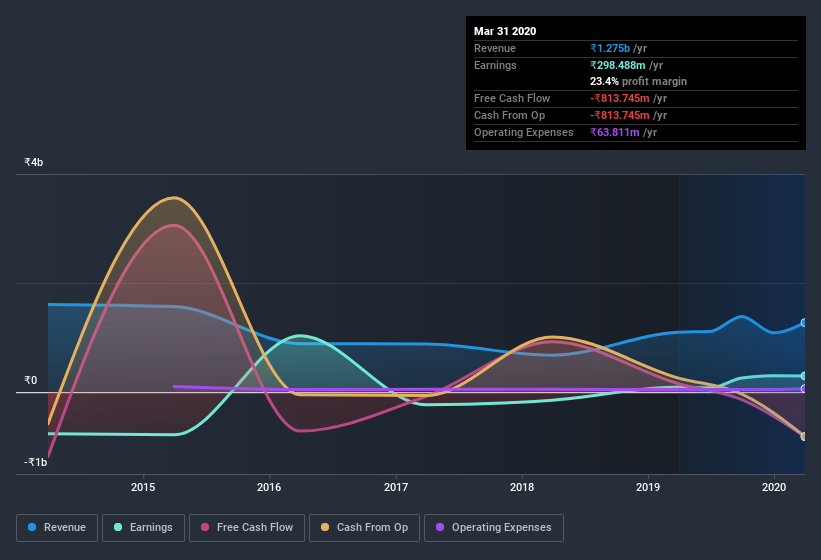- India
- /
- Real Estate
- /
- NSEI:FMNL
We're Not So Sure You Should Rely on Future Market Networks's (NSE:FMNL) Statutory Earnings
It might be old fashioned, but we really like to invest in companies that make a profit, each and every year. Having said that, sometimes statutory profit levels are not a good guide to ongoing profitability, because some short term one-off factor has impacted profit levels. This article will consider whether Future Market Networks' (NSE:FMNL) statutory profits are a good guide to its underlying earnings.
We like the fact that Future Market Networks made a profit of ₹298.5m on its revenue of ₹1.28b, in the last year. The good news is that the company managed to grow its revenue over the last three years, and also move from loss-making to profitable.
View our latest analysis for Future Market Networks

Of course, when it comes to statutory profit, the devil is often in the detail, and we can get a better sense for a company by diving deeper into the financial statements. As a result, we think it's well worth considering what Future Market Networks' cashflow (when compared to its earnings) can tell us about the nature of its statutory profit. Note: we always recommend investors check balance sheet strength. Click here to be taken to our balance sheet analysis of Future Market Networks.
A Closer Look At Future Market Networks' Earnings
In high finance, the key ratio used to measure how well a company converts reported profits into free cash flow (FCF) is the accrual ratio (from cashflow). The accrual ratio subtracts the FCF from the profit for a given period, and divides the result by the average operating assets of the company over that time. You could think of the accrual ratio from cashflow as the 'non-FCF profit ratio'.
As a result, a negative accrual ratio is a positive for the company, and a positive accrual ratio is a negative. While having an accrual ratio above zero is of little concern, we do think it's worth noting when a company has a relatively high accrual ratio. Notably, there is some academic evidence that suggests that a high accrual ratio is a bad sign for near-term profits, generally speaking.
Future Market Networks has an accrual ratio of 0.30 for the year to March 2020. Unfortunately, that means its free cash flow was a lot less than its statutory profit, which makes us doubt the utility of profit as a guide. Even though it reported a profit of ₹298.5m, a look at free cash flow indicates it actually burnt through ₹813.7m in the last year. It's worth noting that Future Market Networks generated positive FCF of ₹154m a year ago, so at least they've done it in the past. One positive for Future Market Networks shareholders is that it's accrual ratio was significantly better last year, providing reason to believe that it may return to stronger cash conversion in the future. Shareholders should look for improved cashflow relative to profit in the current year, if that is indeed the case.
Our Take On Future Market Networks' Profit Performance
Future Market Networks didn't convert much of its profit to free cash flow in the last year, which some investors may consider rather suboptimal. Because of this, we think that it may be that Future Market Networks' statutory profits are better than its underlying earnings power. The silver lining is that its EPS growth over the last year has been really wonderful, even if it's not a perfect measure. At the end of the day, it's essential to consider more than just the factors above, if you want to understand the company properly. If you'd like to know more about Future Market Networks as a business, it's important to be aware of any risks it's facing. For instance, we've identified 4 warning signs for Future Market Networks (1 can't be ignored) you should be familiar with.
This note has only looked at a single factor that sheds light on the nature of Future Market Networks' profit. But there is always more to discover if you are capable of focussing your mind on minutiae. For example, many people consider a high return on equity as an indication of favorable business economics, while others like to 'follow the money' and search out stocks that insiders are buying. So you may wish to see this free collection of companies boasting high return on equity, or this list of stocks that insiders are buying.
If you decide to trade Future Market Networks, use the lowest-cost* platform that is rated #1 Overall by Barron’s, Interactive Brokers. Trade stocks, options, futures, forex, bonds and funds on 135 markets, all from a single integrated account. Promoted
New: AI Stock Screener & Alerts
Our new AI Stock Screener scans the market every day to uncover opportunities.
• Dividend Powerhouses (3%+ Yield)
• Undervalued Small Caps with Insider Buying
• High growth Tech and AI Companies
Or build your own from over 50 metrics.
This article by Simply Wall St is general in nature. It does not constitute a recommendation to buy or sell any stock, and does not take account of your objectives, or your financial situation. We aim to bring you long-term focused analysis driven by fundamental data. Note that our analysis may not factor in the latest price-sensitive company announcements or qualitative material. Simply Wall St has no position in any stocks mentioned.
*Interactive Brokers Rated Lowest Cost Broker by StockBrokers.com Annual Online Review 2020
Have feedback on this article? Concerned about the content? Get in touch with us directly. Alternatively, email editorial-team@simplywallst.com.
About NSEI:FMNL
Future Market Networks
Engages in organizing of wholesale, trade, retail, and logistics infrastructure projects in India.
Low risk and slightly overvalued.
Market Insights
Community Narratives



